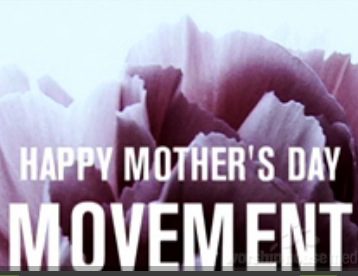Mother’s Day began as a protest against violence. View this brief video reflection on Mothers Day presented by Worship House Media
Mothers Day Central offers the following background..
 History of American Celebration
History of American Celebration
When the first English settlers came to America, they discontinued the tradition of Mothering Day. While the British holiday would live on, the American Mother’s Day would be invented — with an entirely new history — centuries later. One explanation for the settlers’ discontinuation of Mothering Day was that they just didn’t have time; they lived under harsh conditions and were forced to work long hours in order to survive. Another possibility, however, is that Mothering Day conflicted with their Puritan ideals. Fleeing England to practice a more conservative Christianity without being persecuted, the pilgrims ignored the more secular holidays, focusing instead on a no-frills devotion to God. For example, even holidays such as Christmas and Easter were more somber occasions for the pilgrims, usually taking place in a Church that was stripped of all extraneous ornamentation.
Julia Ward Howe’s Mother’s Day Proclamation of 1870
The first North American Mother’s Day was conceptualized with Julia Ward Howe’s Mother’s Day Proclamation in 1870.
Despite having penned The Battle Hymn of the Republic twelve years earlier, Howe had become so distraught by the death and carnage of the Civil War that she called on Mother’s to come together and protest what she saw as the futility of their Sons killing the Sons of other Mothers.
With the following, she called for an international Mother’s Day celebrating peace and motherhood:
Arise, then, women of this day!
Arise all women who have hearts,
Whether your baptism be that of water or of tears
Say firmly:
“We will not have great questions decided by irrelevant agencies,
Our husbands shall not come to us reeking of carnage,
For caresses and applause.
Our sons shall not be taken from us to unlearn
All that we have been able to teach them of
charity, mercy and patience.
“We women of one country
Will be too tender of those of another country
To allow our sons to be trained to injure theirs.”
From the bosom of the devastated earth a voice goes up with
Our own. It says, “Disarm, Disarm!”
The sword of murder is not the balance of justice!
Blood does not wipe out dishonor
Nor violence indicate possession.
As men have of ten forsaken the plow and the anvil at the summons of war.
Let women now leave all that may be left of home
For a great and earnest day of counsel.
Let them meet first, as women, to bewail and commemorate the dead.
Let them then solemnly take counsel with each other as to the means
Whereby the great human family can live in peace,
Each bearing after his own time the sacred impress, not of Caesar,
But of God.
In the name of womanhood and humanity, I earnestly ask
That a general congress of women without limit of nationality
May be appointed and held at some place deemed most convenient
And at the earliest period consistent with its objects
To promote the alliance of the different nationalities,
The amicable settlement of international questions.
The great and general interests of peace.
The Rise & Fall of Howe’s Mother’s Day
At one point Howe even proposed converting July 4th into Mother’s Day, in order to dedicate the nation’s anniversary to peace. Eventually, however, June 2nd was designated for the celebration.
In 1873 women’s groups in 18 North American cities observed this new Mother’s holiday. Howe initially funded many of these celebrations, but most of them died out once she stopped footing the bill. The city of Boston, however, would continue celebrating Howe’s holiday for 10 more years.
Despite the decided failure of her holiday, Howe had nevertheless planted the seed that would blossom into what we know as Mother’s Day today. A West Virginia women’s group led by Anna Reeves Jarvis began to celebrate an adaptation of Howe’s holiday. In order to re-unite families and neighbors that had been divided between the Union and Confederate sides of the Civil War, the group held a Mother’s Friendship Day.
Anna M. Jarvis’s Mother’s Day in 1908
After Anna Reeves Jarvis died, her daughter Anna M. Jarvis campaigned for the creation of an official Mother’s Day in remembrance of her mother and in honor of peace.
In 1908, Anna petitioned the superintendent of the church where her Mother had spent over 20 years teaching Sunday School. Her request was honored, and on May 10, 1908, the first official Mother’s Day celebration took place at Andrew’s Methodist Church in Grafton, West Virginia and a church in Philadelphia, Pennsylvania. The West Virginia event drew a congregation of 407 and Anna Jarvis arranged for white carnations — her Mother’s favorite flower — to adorn the patrons. Two carnations were given to every Mother in attendance.
Today, white carnations are used to honor deceased Mothers, while pink or red carnations pay tribute to Mothers who are still alive.
Andrew’s Methodist Church was incorporated into the International Mother’s Day Shrinein the late 1960’s, and in 1992, became a National Historic Landmark for its significance in the establishment of a national Mother’s Day celebration.
US Government Adoption
In 1908 a U.S. Senator from Nebraska, Elmer Burkett, proposed making Mother’s Day a national holiday at the request of the Young Men’s Christian Association (YMCA). The proposal was defeated, but by 1909 forty-six states were holding Mother’s Day services as well as parts of Canada and Mexico.
Anna Jarvis quit working and devoted herself full time to the creation of Mother’s Day, endlessly petitioning state governments, business leaders, women groups, churches and other institutions and organizations. She finally convinced the World’s Sunday School Association to back her, a key influence over state legislators and congress. In 1912 West Virginia became the first state to officially recognize Mother’s Day, and in 1914 Woodrow Wilson signed it into national observance, declaring the second Sunday in May as Mother’s Day.
The Fight Over Commercialization
The holiday flourished in the United States. Flowers, especially white carnations, became a very popular part of the celebration. One business journal, Florists Review, went so far as to print, “This was a holiday that could be exploited.” But the budding commercialization of Mother’s Day greatly disturbed Jarvis, who vociferously opposed what she perceived as a misuse of the holiday.
In 1923 Jarvis sued to stop a Mother’s Day event. In the 1930’s she was arrested for disturbing the peace at the American War Mothers group: She was protesting their sale of flowers. Jarvis also petitioned against a postage stamp featuring her Mother with a vase of white carnations and the word “Mother’s Day.” Jarvis was able to have the words “Mother’s Day” removed … but the flowers remained.
In 1938, Time Magazine ran an article about Jarvis’s fight to copyright Mother’s Day, but by then it was already too late to change the commercial trend.
In opposition to the flower industry’s exploitation of the holiday, Jarvis wrote, “What will you do to route charlatans, bandits, pirates, racketeers, kidnappers and other termites that would undermine with their greed one of the finest, noblest and truest movements and celebrations?” Despite her efforts, flower sales on Mother’s Day continued to grow. Florist’s Review wrote, “Miss Jarvis was completely squelched.”
Anna Jarvis died in 1948, blind, poor and childless. Jarvis would never know that it was, ironically, The Florist’s Exchange that had anonymously paid for her care.
Tags: Mother's Day, peace

